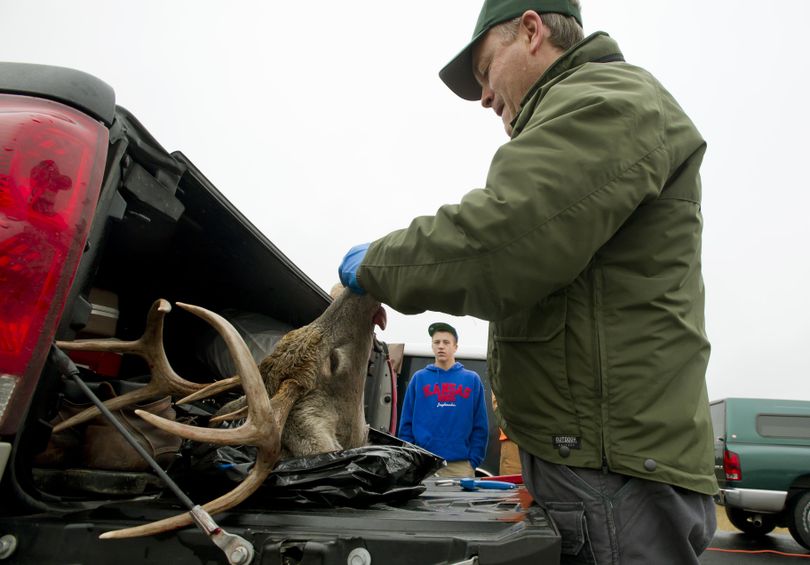Chronic wasting disease confirmed in Montana mule deer

HUNTING -- Lab tests have confirmed chronic wasting disease in a mule deer buck killed Oct. 22 by a hunter in Hunting District 510 south of Billings, Montana Fish, Wildlife and Parks officials reported today.
- Now that Montana is a CWD-positive state, it's likely to be added to the list of states from which certain game animal parts cannot be brought across state borders into Washington. See the rules on page 65 of the current Washington Hunting Seasons and Regulations pamphlet.
Two independent tests were positive for the disease in the buck taken 10 miles southeast of Bridger. Testing on another buck suspected of having CWD will be complete next week. That buck was taken by a hunter Nov. 5 about 3 miles south of Belfry, also in HD 510.
Montana has set up a multi-agency incident command team to develop a plan to prevent spread of the disease, which is fatal to deer, elk and moose. There's no evidence that CWD is is a threat to humans, officials say. However, fish and wildlife officials around the region recommend that people should avoid consuming meat from sickly animals.
A tentative plan being reviewed calls for establishing an initial response area for a Special CWD Hunt. A hunt could be established after the general hunting season ends to specifically target deer in the infected area. "The goal of the hunt would be to harvest enough mule deer to establish disease prevalence and distribution," FWP officials said in a release.
Following are advisories from Montana wildlife officials:
For Hunters
Though there is no evidence CWD is transmissible to humans, it is recommended to never eat meat from animals that appear to be sick or are known to be CWD positive. The Centers for Disease Control and Prevention recommends hunters who have harvested a deer, elk, or moose from a known CWD-infected area have the animal tested prior to consuming it. If hunters harvest an animal that appears to be sick, the best thing to do is contact FWP and have the animal sampled.
Some simple precautions should be taken when field dressing deer, elk or moose:
- Wear rubber gloves and eye protection when field dressing.
- Minimize the handling of brain and spinal tissues.
- Wash hands and instruments thoroughly after field dressing is completed.
- Avoid consuming brain, spinal cord, eyes, spleen, tonsils and lymph nodes of harvested animals. (Normal field dressing coupled with boning out of a carcass will essentially remove these parts.)
Montanans need to remember that Montana law prohibits the import of heads and spinal columns of deer, elk or moose harvested in states or provinces that have CWD in wild or captive populations.
Out of state hunters should check their state’s carcass transport restrictions since Montana is now a CWD-positive state.
Hunters should also dispose of carcass waste in a Class 2 landfill. A class 2 landfill accepts all solid waste, except regulated hazardous waste. Most major landfills in Montana are class 2. However, if you have any questions, contact city or county public works director. Disposing of carcass waste on the landscape is considered littering and it may facilitate the spread of CWD.
Additionally, hunters who are concerned about whether the deer, elk or moose they harvest is infected with CWD should have the animal tested. If the animal was harvested in the priority surveillance area, the sampling can be done at one of the check stations operated in Big Timber, Billings, Columbus, Laurel, or Lavina on Saturdays and Sundays during the general season or at the FWP Region 3 office in Bozeman or the Region 5 office in Billings. If the animal is harvested outside the priority surveillance area, hunters can follow the directions on the web at fwp.mt.gov/CWD to take and submit their own samples for testing.
Background
The area where the suspect and positive samples were discovered is part of the FWP priority CWD surveillance area. FWP staff are collecting samples from hunter-harvested deer in south central Montana hunting districts. Most samples are collected at check stations and hunters receive a card with a sample number used to check test results. FWP is encouraging hunters who harvest deer within the priority CWD surveillance area, and especially hunting districts 502 and 510, to submit their animals for testing. If this is not done at a check station, hunters can call or come to the FWP Region 5 office on Lake Elmo Drive in Billings at 406-247-2940 from 8-5 weekdays.
CWD is a progressive, fatal disease affecting the central nervous system of mule deer, white-tailed deer, elk and moose. It is a slow-moving disease. However, left unmanaged, it could result in long-term population declines within affected herds.
For more information, look online at fwp.mt.gov/CWD.